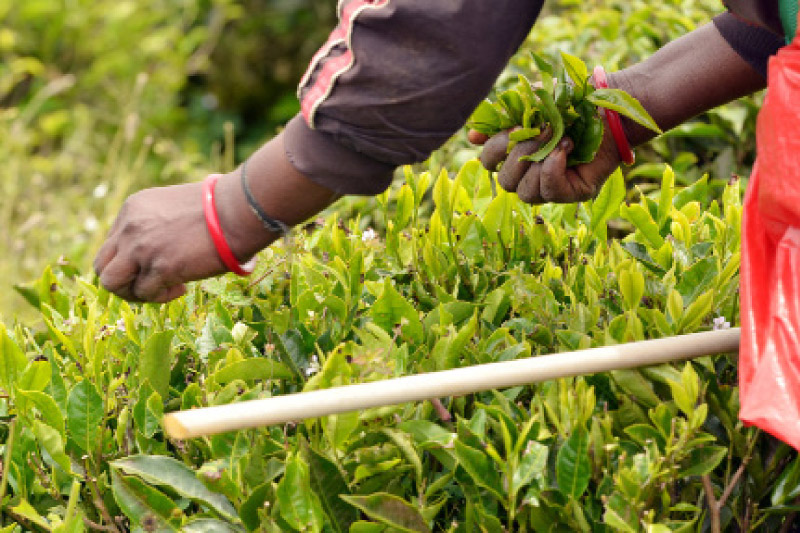Sunday Nov 30, 2025
Sunday Nov 30, 2025
Wednesday, 2 June 2021 00:00 - - {{hitsCtrl.values.hits}}

Some of our plantations have been driven to closure due to being governed entirely by location, climate, market conditions and dependent almost exclusively on auction determined pricing for what they produce – Pic by Shehan Gunasekara
 Integrating and optimising value in the chain of supply
Integrating and optimising value in the chain of supply
One of the main limiting factors to create greater value from Ceylon Tea for all who participate in the different aspects and stages of production and supply is the constant strain and tension between the different links in the value chain. The different stakeholders are divided and fragmented and not pulling together to reach common goals.
This results in frequent conflicts and stress between, workers/small holders larger plantations/factory owners/RPCs and buyers, dissipating productivity, efficiency, time and energy while passing on the potential value to be earned locally, to foreign overseas links in the tea supply chain. It is the large brand players who are often multi nationals and FMCG retailers who dominate the global market place where the real wealth in tea is created and who reap the benefits for what Sri Lanka produces. Is it not our people who should be the ultimate beneficiaries rightfully for their sweat and toil?
Extending beyond our shores the value chain to markets overseas
Our trade and industry have long been satisfied in merely taking value for the greater volume of tea exported from our country primarily benchmarked on weekly Colombo auction prices. These price levels are determined by global demand and supply being a commodity. The market is often unpredictable and volatile. This reliance on the auction mechanism is based on the age-old British model and though the matter is entirely a matter for us we continue to be blinded and oblivious to the potential opportunities available outside our shores. For the real value of tea to flow to our country and to the key stakeholders across the entirety of the supply chain and our national economy we need to be more creative in how we present our tea not to other businesses overseas but to the consumer directly wherever possible.
In my view auction prices in Colombo should be exclusively an internal matter. When demand at the auctions is depressed, it is in our national interest that we should have a cushioning mechanism in place to protect the local producers. The more finished consumer products Sri Lankans offer directly in the main markets for tea, the less correlation there will be between auction pricing and the prices dictated by the prevalent business to business weekly buying. This breakthrough is long overdue.
The country’s tea supply chain still terminates at Sri Lankan ports
Up to the time the transfer of British interests in Ceylon Tea to Sri Lankan ownership in 1975 took place, it is perhaps understandable that British controlled export companies based in Sri Lanka were shipping our tea to London and also to other designated locations of their choice in a business under their full control. Ceylon Tea served the common interests of European companies for nearly a century, where foreigners enjoyed the greatest share of the value from our tea. We may have accepted this as being perhaps unavoidable at that time.
However, what is inexcusable now is that even after transfers of management first, and later ownership, took place in the last quarter of the last century, the young Sri Lankans trained and employed in that period by those British export houses – the remnant of the old British model have replaced their foreign predecessors who taught and trained them with a near identical operation without question, by setting up businesses of their own and for the large part continued with exporting auction purchased tea, merely primary processed with little or no value addition. This continues to-date serving parties foreign to Sri Lanka who derive the greater benefits and value from Ceylon Tea.
 Proposed transformation to market tea rather than trade in it
Proposed transformation to market tea rather than trade in it
As a country desperately in need to improve export revenues in the current context and particularly so in the tea sector where a major part of our population places reliance on it for their livelihood, we need to urgently remodel the mechanisms and entities responsible to market our tea. This is in sharp contrast to merely trading in the commodity and shipping tea in bulk which is the long-established norm in this country with only a very slow process of a shift to value addition being evident. We would be optimistic to continue to consider unit weight reduction in tea exports as a method of generating value addition.
Extending the supply chain and entry into marketing
While retaining the expertise, skills and core competencies of personnel available and engaged in the tea sector both in cultivation, scientific research, production, technology, trading and specialists who possess organoleptic skills capable of creating tea solutions based on market research and their palates, combined with world class marketing specialists in FMCG, what is suggested is the formation of large public companies with shares held by all stakeholders and workers in the industry to share in the greater value available to Sri Lanka by extending the value chain in tea to overseas markets.
This would entail large investments to be made in marketing, distribution, promoting and retailing where local interests are represented in the value chain right across to the point of our tea reaching the consumer. The size of the investment may be massive but fortune would only favour the brave. An example of a success story is Dilmah who dared first to be different amongst our local entrepreneurs. Few others have followed and I dare say are reaping the benefits.
How do we fund the investment needed?
The stakeholders in tea which may number at least a million and a half of our working population would be collectively having huge balances to their credit in their retirement funds. There is every justification for a part of these funds to be channelled to form the initial seed capital required for the kind of investments required and to represent the stakeholder interest for all who work for tea starting with the plantation worker. The value of their fund balances will be at retirement only a mere fraction of the value in the years in which they contributed to these funds. In contrast their holding a stake in the company they work for should contribute to greater outcomes and results across the whole value chain with the realisation that they are working for their own future.
The government and banks would find it easier to extend additional facilities for these public commonly owned people’s entities to develop and grow rather than continuing to support entities who presently do not really add to enhance our earnings as a country from tea YOY. Our forex earnings from tea have remained at constant levels for the last 10 years.
Innovation, creativity and entrepreneurship
Sri Lanka, it was heartening for me to discover only very recently, has a new generation of young, courageous and determined young men and women to take Ceylon Tea to greater heights treading boldly on a new and different path. An exciting new category and a product segment in tea is emerging and indeed from the webinar on the subject of ‘Artisanal Teas’ two weeks ago, it appears it already has. See link: https://us02web.zoom.us/j/89535798612.
Artisanal Teas
What is even more fortuitous and encouraging for these courageous young breed of entrepreneurs is that market research in the most sophisticated global markets for specialty teas points clearly to a growing segment of consumers for this class of tea especially amongst the millennials who are equally concerned not only with the quality and taste of the products but even more so as to the equity amongst all those engaged in producing it, the conduct of business to the highest ethical code with the greatest respect for the environment.
For very long we have all stayed far too long in the traditional mould in tea not bold enough or sufficiently imaginative to break out and do things differently. Some of our plantations have been driven to closure due to being governed entirely by location, climate, market conditions and dependent almost exclusively on auction determined pricing for what they produce. Amongst the younger consumers of beverages, a trend and a shift away from traditional beverages like Black Tea has been noticeable. This coupled with not being courageous to enter global markets for want of resources does not augur well and have left the whole local chain of supply poorer right down to the plantation worker driven to the lowest ebb of poverty and distress.
However, amongst the gloom and doom of uncertainty and unsustainability there is still hope in the form of a rainbow in the firmament of Ceylon Tea, symbolising promise. With this breakthrough by this young group of young and determined men introducing the Artisanal Teas of Ceylon, it is our hope that many others would emulate their example and create new and innovative strategies to get more value from our tea. Consumers nearly everywhere, not only for tea but for all food items and beverages, the young more so than others, are interested in the stories behind the products.
Authenticity
The 150-year-old and more history of Ceylon Tea amply provides for this need for the tale. There lies an opportunity of talking about, apart from authenticity, care, consciousness of ethical standards, sound eco-friendly practices and due regard for the environment in how we produce our tea. Moving onwards from the differentiation pointed out in the paragraph above there is also the matter of providence which has not been used to its full potential to differentiate our tea from nearly all our rivals where our firmest claim is the ‘superiority of flavour’ and the agro climatic distinction in the variety we offer.
Nobody explains exactly how this superiority comes about at 4,000 to 6,000 feet above sea level in our central hills. This mysticism of what nature has so abundantly endowed on us with strong winds, cool nights and rain when required and when not, will re-create that conversation amongst the millennials of today and that is what I would recommend we work on and use to re-position Ceylon Tea.
(The article is entirely the writer’s personal view point and not associated with any views held by his business connections or associates. He may be contacted on [email protected])